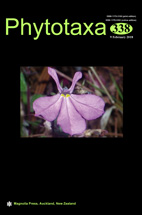Abstract
Lecanorchis Blume (1856: 188) comprises about 30 species of mycoheterotrophic orchids (Seidenfaden 1978, Hashimoto 1990, Szlachetko & Mytnik 2000, Govaerts et al. 2017) characterized by having numerous, long, thick, horizontal roots produced from a short rhizome, presence of a calyculus (i.e. a cup-like structure located between the base of the perianth and apex of the ovary) and an elongate column with a pair of small wings on each side of the anther (Seidenfaden 1978, Hashimoto 1990). The genus is distributed across a wide area including China, Korea, India, Indonesia, Japan, Laos, Malaysia, New Guinea, Pacific islands, the Philippines, Taiwan, Thailand and Vietnam (Seidenfaden 1978, Hashimoto 1990, Pearce & Cribb 1999, Szlachetko & Mytnik 2000, Averyanov 2011, 2013).

